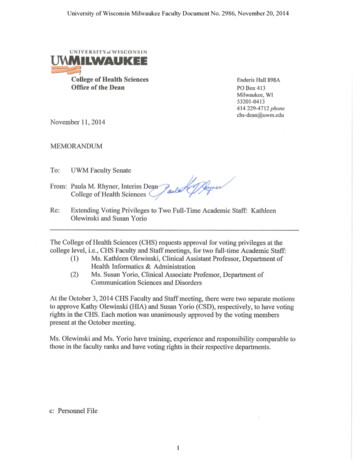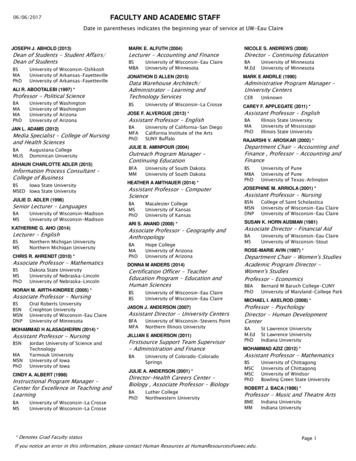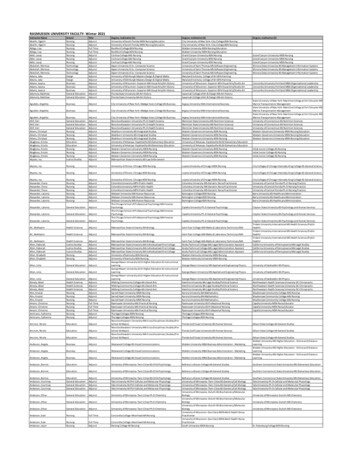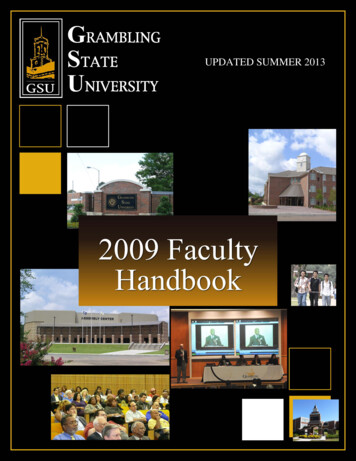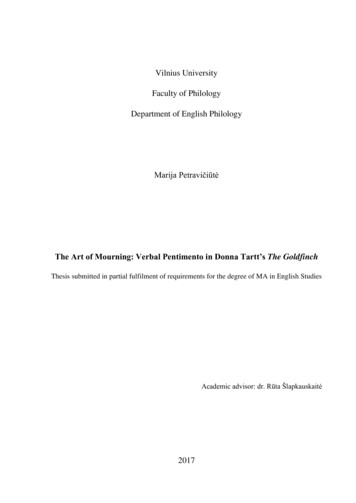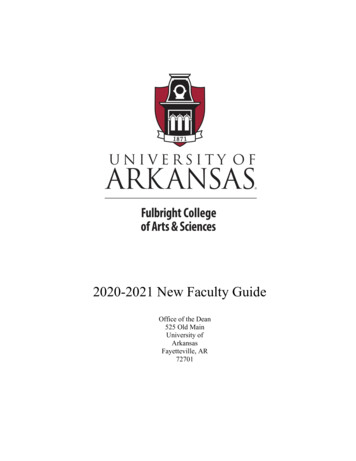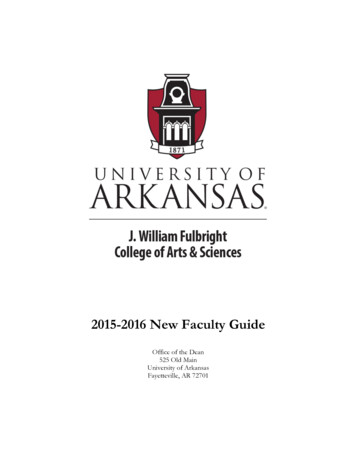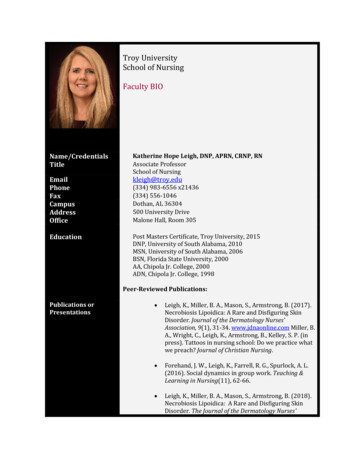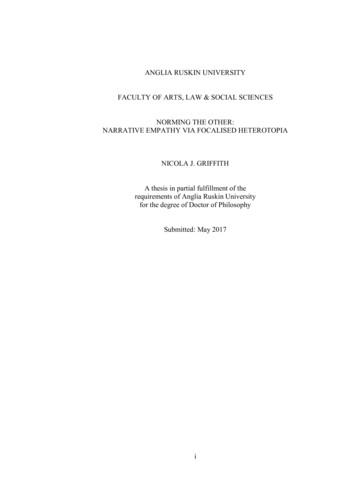
Transcription
ANGLIA RUSKIN UNIVERSITYFACULTY OF ARTS, LAW & SOCIAL SCIENCESNORMING THE OTHER:NARRATIVE EMPATHY VIA FOCALISED HETEROTOPIANICOLA J. GRIFFITHA thesis in partial fulfillment of therequirements of Anglia Ruskin Universityfor the degree of Doctor of PhilosophySubmitted: May 2017i
ANGLIA RUSKIN UNIVERSITYABSTRACTFACULTY OF ARTS, LAW & SOCIAL SCIENCESDOCTOR OF PHILOSOPHYAMMONITE, SLOW RIVER, THE BLUE PLACE, STAY, ALWAYS, AND HILD&NORMING THE OTHER: NARRATIVE EMPATHY VIA FOCALISEDHETEROTOPIANICOLA J. GRIFFITHMay 2017This critical commentary argues that the novels submitted (emphasis on Ammonite, TheBlue Place, and Hild, with three others, Slow River, Stay, and Always brieflyreferenced), form a coherent body of work which centres and norms the experience ofthe Other, particularly queer women. Close reading of the novels demonstrates howspecific word-choice and metaphor locate the examination of a focalised character’sbody in its physical and sensory setting. This examination of the body is referred to asembodiment. The commentary argues that embodiment of the focalised characteractivates neural mechanisms within the reader to create and sustain narrative empathy.It explores the creation of focalised heterotopias and the narrative consequences forcharacters traditionally marginalised in our society but not in their own.Keywords: writing the other, queer literature, embodied empathy, focalised heterotopia,narrative empathy, historicity literature, gender discourse literature, word choicei
ContentsIntroduction . 1Part One: Theoretical Underpinnings1. Running My Software on Readers’ Hardware: Narrative Empathy . 42. Excluding to Include: Focalised Heterotopia . 6Part Two: R/Evolution3. Far and Near: The Future (Ammonite and Slow River) . 94. Turbine Dreams: The Present (The Blue Place, Stay, and Always) . 185. What I Desire: The Pasta. Situating Hild . 25b. Writing Hild . 28Conclusion . 38Works Cited . 41Appendix: Critical Reception . 47Note:As the glosses can be substantial this critical review employs footnotes instead ofendnotes.ii
Copyright 2017 by Nicola J. Griffithiii
IntroductionI write to find out and, in the process, change the world one reader at a time. AdrienneRich said, “We must use what we have to invent what we desire” (Rich 1993: 215), andI desire a world where we are all, regardless of our identities, regarded by one anotheras human beings. I build worlds and populate them with women and other members oftraditionally maligned groups who behave, and expect treatment, as full human beings.I create milieux so immersive that readers are eager and able to recreate and simulatethe experiences of the characters inside themselves: the protagonist’s feelings andlessons become the reader’s, in scenarios enticing and vivid enough to facilitatenarrative empathy. Through empathy I seek to alter the reader’s standpoint long enoughto persuade them to consider women and other members of traditionally malignedgroups—whether queer, poor, disabled, or people of colour—to be as human as thereader themselves. I aim to norm the Other.The first stories I absorbed were oral fairytales. Reading followed: myths andlegends first, then an indiscriminate gulping of everything within reach.1 Inadolescence I discovered types of story that reliably delivered the frisson I had firstfound in fairytale and myth: adventure fiction, such as She (Haggard 1888), sciencefiction, such as Dune (Herbert 1965); and adult historical fiction by authors such asRosemary Sutcliff. My favourite fiction had fast-moving events; close attention to thevarying emotion and psychological growth of the protagonist; intellectual engagementwith something unknown; and, most of all, physical freedom in and enjoyment of thenatural world. But I learnt very early that people like me were not represented in1Literally. My local library seemed to operate on the principle that if you could reach ashelf you could borrow the books it held.1
stories, that only male characters were free to have adventures.As a writer I seek to represent people like me and to norm the Other,particularly queer women. I draw from diverse traditions and genres, includinghistorical fiction, lesbian fiction, science fiction, crime fiction, literary fiction, andnature writing. I strive for a balance between the eventful epic and the intimate,psychological novel. For me, genre is a tool, a vehicle to traverse specific story terrains.An imagined reader will bring different attitudes and expectations to bear on anyparticular genre text: I consciously partake of genre conversations in order to harnessand/or subvert the reader’s expectations.In this critical review I argue that, in order to norm the Other, my body of workcreates reader empathy with members of traditionally maligned groups via theconstruction of focalised heterotopias. The review consists of two parts.Part One, Theoretical Underpinnings, is divided into two chapters. Chapter One,on narrative empathy, argues that fiction can trigger mirror neurons which enable areader to construct a character’s actions and emotions inside themselves; thisconstruction facilitates empathy, but that narrative empathy can be obviated by areader’s aversive emotional response. I respond to this in Chapter Two, on focalisedheterotopia, my portmanteau term based on the focalisation theories of Mieke Bal(1985) and Gérard Genette (1972), and Michel Foucault on heterotopia (1986), andargue that situating the focalised character within a heterotopia that excludes theoppressive discourse associated with membership of maligned groups may precludetriggering an aversive emotional response.Part Two, R/Evolution, presents three close readings of a novel or group ofnovels. Chapter Three concerns my science fiction novels and considers my evolution2
from writing general heterotopia in Ammonite (1993) to focalised heterotopia in SlowRiver (1995). I argue that my use of metaphor partly facilitates the construction offocalised characters. Chapter Four examines my contemporary crime novel series, withparticular attention to The Blue Place, and argues that embodiment of the focalisedcharacter is essential to the construction and maintenance of empathy for a femalenarrator who is unlike her literary predecessors. Finally, Chapter Five considers myhistorical novel, Hild. It situates the novel in context of other historical fictions andexamines the novel’s use of language, metaphor, and the embodied character’sreflection of and in her early medieval landscape to norm the Other.The conclusion summarises my argument that my fiction is a coherent body ofwork whose goal is to norm the Other, and that in achieving this goal I unite previouslydivided narrative paths.My appendix offers a list of the novels’ critical reception including literaryprizes and other honours.3
Part One: Theoretical Underpinnings1. Running my software on their hardware: narrative empathySome neuroscientists theorise that mirror neurons are human brain cells activated whenwe perform actions and when we observe others performing those actions.2 Mirrorneurons let us recreate others’ experience, emotions, and motivations inside ourselves;they may be foundational to human empathy.3 Zanna Clay and Marco Iacoboni assert(2012), via empirical analysis of recent neuroscience, including that of functionalMRIs, that reading can trigger mirror neurons, thus enabling readers’ internal recreationof a characters’ actions and emotions and constructing narrative empathy.Reading fiction not only promotes empathy; it can also lead to real-worldchange. Kevin Oatley (2011) offers evidence that a reader is able to infer well-drawncharacters’ thoughts and intentions and that it is partly the work the reader does to piecetogether the clues offered by an author that leads to understanding of a character’smotivations. Suzanne Keen (2006) posits that a reader’s knowledge that they arereading a story plays a positive role in empathetic response: the knowledge releasesthem from “the obligation of self-protection” inherent in real-world situations, although“an appropriately inspiring social context, or an emergent structure of feelingpromoting change may be necessary for efficacious action to arise out of internalizedexperiences of narrative empathy” (220).There is a caveat. Narrative empathy can be obviated by a reader’s negativeemotions. If we observe suffering that we associate in some way with our own2This is a not uncontroversial topic (possibly because of exaggerated claims advancedby the popular press). James Kilner and Roger Lemon (2013) have a useful overview ofthe current understanding.3Keen defines empathy as a “vicarious, spontaneous sharing of affect” (2006: 208).4
situation, we may experience personal distress and respond with an aversion that “leadsnot to sympathy but to avoidance,” a “turning-away from the provocative condition ofthe other” (208). Therefore, to norm the Other I employ strategies to avoid aversiveemotional response in the particular arenas upon which my fiction focuses. Whenwriting from the perspective of a queer woman I avoid taking the reader into anoverwhelming experience of gender discrimination or sexual violence, or thehomophobic violence (and threat of same) often experienced by those who identify (orare identified by others) as lesbian or bisexual women. I find worm-turns fiction4regressive and have little patience for pleading for equal treatment. I prefer to movebeyond both Foucault’s reverse discourse (1976) and Eve Kosofsky Sedgwick’sreparative reading (1996). Rather than delineating the oppressions experienced bytraditionally maligned groups, the struggles to overcome those oppressions, or whatmight happen if power positions were reversed, I have chosen to selectively excludecurrent oppressive discourse and structures which pertain to gender and sexualorientation.The pro-social outcomes of narrative empathy can be facilitated by unconsciousaffiliations. Clay and Iacoboni note growing evidence that the more familiar thesituation or actions of a character, the more easily a reader’s mirror neurons areactivated. Keen adds that when adult readers feel empathy for a character they tend to“experience empathy most readily and accurately for those who seem like us” (2006:214; my emphasis). Also, Oatley quotes the work of Melanie Green and Tim Brook,who argue that immersion in a story leads to text inducing “empathy for the people of4Role-reversal in which the traditionally oppressed gain the upper hand and oppresstheir former oppressors.5
minority status” (2011: 172). I contend that the more precisely a writer limns specificcharacter experience, the more readily a reader will empathise with that character.I take particular care to create immersion for the reader by exploring acharacter’s physical sensations and emotions. To build and maintain empathy for acharacter, whether or not she belongs to the same in-group as the reader, it is essentialto create similarities with a reader’s potential experience. I do this through a focus onembodied needs. Maslow (1943) argues that generally human beings experience certaincommon physiological and psychological needs. Keen argues (2006: 226) that elation,triumph, satisfaction and sexual arousal are all good examples of the emotions thatmight facilitate empathy. Embodiment facilitates narrative empathy via the portrayal ofboth need and joy.2. Excluding to include: focalised heterotopiaMarghe, and to a lesser extent Danner, in Ammonite; Lore in Slow River; Aud in TheBlue Place (and its sequels Stay and Always); and Hild in Hild are the lenses throughwhom the reader encounters events. The narrative is focalised through the protagonist’sexperience and this shapes the narrative. Burkhard Niederhoff (2013), followingGenette (1972), defines focalisation as “a selection or restriction of narrativeinformation in relation to the experience and knowledge of the narrator, the characters(.) in the storyworld” (n.p.). My focalised characters are all women and all queer, whoas members of traditionally maligned5 groups would normally suffer oppressive5Throughout I use the term ‘maligned’ to mean reviled, mistreated, abused,subordinated and discriminated against.6
discourse and its concomitant punishments.6 However rendering this suffering wouldlikely create an aversive emotional response which would work in opposition to theconstruction of narrative empathy.7 Without empathy, the narrative cannot change thereader’s standpoint or cognitive script (Stockwell 2002: 77), even temporarily, to normthe Other.8 To norm the fictional Other requires both realism (see below) and theexclusion of empathy-repelling experiences associated with being queer and/or awoman.Empathy is easier to create for characters in circumstances to which a readermight be willing to relate. To create narrative empathy sufficient to norm the Other mynarratives construct heterotopias, spaces of “alternate ordering” that can “interrogatedominant ideologies” (Hetherington 2002: viii). My heterotopias differ from most, Iargue, in that they pertain only to the focalised character; they are focalisedheterotopias. I create worlds—in the future, the present, and the past—which excludethe operation of certain oppressions and oppressive discourses. My focalised charactersdo not surmount the oppressions of traditionally marginalised groups; they simply donot experience them. This, I submit, is what readers and critics point to when they6In the cultural master story (Griffith 1997 and 2010), and in some of the genres withwhich my work is in conversation—for example historical fiction and noir—women'sbodies have traditionally been, and often still are, the locus of their suffering: womenare the corpse left when the psychopath has done his work; we are the war prize to becarried off.7There are those who argue that because attitudes have changed sufficiently this mayhave been true at the time I wrote the earlier novels, but is no longer. I disagree. Justbecause some laws have changed does not mean our essential stance to and expectationof the world has.8“[A] standpoint.refers not to a rigid or permanent stabilization of perspective, butrather to a fluid and dynamic negotiation of experience and point of view that can betemporarily stabilized in order to interrogate dominant ideologies” (Lenz 2004: 98).7
describe my work as “armed to the teeth against convention” (Interzone, 1993).8
Part Two: R/Evolution3. Far and Near: The FutureMy two science fiction novels, Ammonite (1993) and Slow River (1995), normalisequeer female characters in the future. Ammonite, my first novel, is a general heterotopiaset on an all-women planet in the far-future. It excludes the oppressions related togender and sexual orientation by excluding gender altogether. Slow River (1995), mysecond novel, excludes these oppressions via a focalised heterotopia set in the nearfuture.Ammonite owes a great deal to my reading response to many science fictional(SF) works. None came close to what I sought: queer women who were human in, of,and for themselves, and free to be so in the entirety of their world, including theoutdoors. I read tales of isolated utopias, women-only communities such as CharlottePerkins Gilman’s Herland (1979), populated by alarmingly homogeneous blonde-andblue-eyed white women; this struck me as much a product of eugenicist politics asfeminism. Daphne du Maurier’s mysterious mountain fastness in “Monte Verità”(1952) felt more like a metaphor for withdrawal than a reimagining of possibilities. Itried various SF sex-battle texts9 in which the sexes are explicitly in conflict, rangingfrom E.E. ‘Doc’ Smith’s apparently sex- and loveless Lyranians (1953-1954) to JohnWyndham’s “Consider Her Ways” (1956). In these male-authored stories, women werepresented as less than human: hive-minded, and/or asexual. I read the science-fantasygender explorations of Marion Zimmer Bradley’s The Shattered Chain (1976), whichdwelt on suffering to the degree that it reads as an anti-feminist cautionary tale: this is9For more on this, see Justine Larbalestier’s The Battle of the Sexes in Science Fiction(2002).9
what happens when you step outside the boundaries of gender. Ursula K Le Guin’s TheLeft Hand of Darkness (1969) posits a genderless alien race: I admired but was notmoved by its assumption of the ‘universal’ male pronoun and its cool intellectualism.10I found Suzy McKee Charnas’s Holdfast novels (1974, 1979) much more emotionallyengaging and immersive, though the naked rage and visceral warfare between the sexesdid not ultimately appeal to me, nor did the arid setting which felt inimical to life.Conversely, initially I found the setting of Sally Miller Gearhart’s The Wanderground(1979) wonderful: women-only enclaves in fecund hill country whose people roamedas freely as Charnas’s horse women. However, on a second reading I could not acceptthe essentialism of the premise: men were irremediably violent because they were men(“It is not in his nature not to rape” [Gearhart 1979: 25]). This essentialism wasreinforced in the novel’s stark binary of technology and nature, with the accompanyingvalue judgment (a staple of 1980s feminist SF) that nature is Good while technology,unless based on ‘alternative science’ such as magic or telepathy, is Bad.Perhaps the text that influenced Ammonite most was Joanna Russ’s short story“When It Changed” (1972). The two narratives have much in common: a newlyrediscovered human colony on another planet struck hundreds of years ago by anepidemic that killed all the men. The planets Whileaway (Russ) and Jeep (Griffith) arepopulated entirely by women who know nothing of men and consequently nothing ofgender roles: women fill all the roles—desiring and desired, smart and stupid, vicious10Like Ammonite, the novels of both Bradley and Le Guin feature ice and snow. Thereis a long and honourable tradition in feminist SF of coldscapes. What is the attraction?There have been various suggestions but the most likely is, as Robin Roberts (1993)suggests, a variation on the Demeter myth which I interpret as the winter landscapebeing a metaphor for life springing from apparent death. That is, change.10
and kind, protagonist and antagonist—and occupy all points of the moral compass. Onboth Whileaway and Jeep women form relationships, reproduce, and create families.However, there are essential differences. On Whileaway the plague agent is no longeractive, and it is men, not women, who are the newly-arrived rediscoverers.11I read most of “When It Changed” wrapped in a shining vision of women ashuman beings in and of themselves rather than in relation to men; women who were nomore and no less than people. Women were free to be themselves in all aspects of theirlives, going where and when they liked without fear. Then, on the second-to-last page, Icame to a paragraph that dashed my shining vision:He went on, low and urbane, not mocking me, I think, but with the selfconfidence of someone who has always had money and strength to spare,who doesn’t know what it is to be second-class or provincial. Which isvery odd, because the day before, I would have said that was an exactdescription of me. (Russ 1975: 257)The men would destroy everything because they were men; the women would loseeverything because when faced with men they knew they were merely women. Theending rests on the essentialist premise of the weakness of women. It felt to me afailure of imagination or a failure of nerve.12In Ammonite the planet Jeep has been ravaged by a virus that killed all the menand many of the women of an early wave of colonists so many generations ago that allknowledge of it has been lost to the present inhabitants. Jeep and its different cultures isrediscovered and reinvaded by a multi-world corporation bent on extracting natural11And if we are to believe a character in Russ's follow-up novel, The Female Man,perhaps the epidemic, viral or otherwise, never existed. The female survivors may havetold themselves a story to salve a murderous conscience. “That ‘plague’ you talk of is alie. I know” (Russ 1975: 211; emphasis in original).12It is possible to infer that Russ also meant this feeling of inferiority to reflect theoppressions of colonialism but frankly it feels like a stretch.11
resources, until the corporate employees they send are also struck by the virus.It is not a ‘world of women’ because without men, without even the memory ofmen, there can be no biological gender; there can be no women. Without women thereare no lesbians. It is a world of people who do not feel second-class by reason of sex orsexual orientation.13Ammonite is a linear novel with two focalised characters. There are notraditional gender categories and so no association of ‘feminine’ with nature, nurturing,kindness or meekness. There is no binary choice (with its accompanying valuejudgments) between technology and nature, nor does the narrative employ magic,telepathy, or other ‘alternative science’.14 It explicitly engages with and rejects parts ofwhat at the time had become feminist creed: that women are wiser, kinder, morenurturing and attuned to the earth than men, because we are women.The novel is written from the third-person perspectives of two focalisedcharacters, Marghe and Danner, in a strict pattern in which two chapters from Margheare followed by one from Danner. I chose this point of view and structure for threereasons. First, by seeing Marghe through Danner’s eyes and vice versa, the reader getstwo distinct perspectives, military and anthropological, on the various native andinvading cultures. Second, the 2:1 structural pattern enabled me to construct thecharacters’ mutual intersubjectivity which bypasses some of the limitations of close13Monique Witting, in “One is Not Born a Woman,” said it most succinctly: “Once theclass ‘men’ disappears, ‘women’ as a class will disappear as well” (1992) and so, byextension, will lesbians.14In this I differ from critics who suggest that on Jeep the conception of children isfantasy, a ‘plausible impossibility.’ My argument is that almost all extra-planetaryscience fiction is on some level fantasy (faster-than-light-drive is downrightimpossible) but while what I describe is implausible it has not been shown to beimpossible.12
third point of view. This formal narrative rhythm is designed to set up and fulfillreaders’ pattern-recognition expectations and so facilitate pleasure and thereforeengagement. Third, the reader experiences the contrast between Marghe’s exploratorymind frame, mostly spent out of doors, and Danner’s sense of being trapped, mostlyindoors.Ammonite is science fiction. My assumed reader was a practiced genre readerfamiliar with the narrative traditions of planetary exploration and at least aware of someof the gender explorations of the genre. I thus felt free to invent and explore alien flora,fauna, and material culture secure in the knowledge that the reader could suspend theimmediate urge to fill in the gaps left by the writer: SF readers understand that a writerwill, eventually, make everything clear; that the systems and events will make senselater, in context, but might not do so if immediately interpreted based on the reader’sown contemporary surroundings.15I had few qualms, then, about plunging the reader immediately into the new: aspace station orbiting a planet in an extra-solar system. The novel opens with ametaphor made concrete: Marghe is about to cross the threshold to another world, anirrevocable choice manifested in a physical step. In the narrative aboard the station, thereader is placed in an artificial environment alongside Marghe, who feels stressed,alone, and overwhelmed by the new:The suit was wrinkled and smelled of just-unrolled plastic, and she feltheavy and awkward, even in the two-thirds gravity of orbital stationEstrade (.) She rested the fingertips of her right hand on the smoothceramic of the raised hatch frame; it was cool, shocking after two days ofthe close human heat of A Section. (Griffith 1993: 1)15See Maria Nikolajeva (2005) for more on the implied reader.13
We smell what Marghe smells and feel what she feels. Her surroundings are hardedged and inimical. The first colour mentioned is red, signalling danger, and hardsurfaces are juxtaposed against Marghe’s soft organic systems.Once we are planetside, though, the tone shifts:The doors cracked open and leaked in light like pale grapefruit squeezingsmaking the artificial illumination in the gig seem suddenly thick and dim(.) She sniffed, trying to equate the spicy sweet smell on the wind tosomething she knew: nutmeg, sun on beetle wings, the wild smell ofheather. (24)The first colour is green; the light is bright and welcoming. We have the sense of awide world, alien but enticing. These orientalised associations, initially subconsciouson my part, parallel Marghe’s gradual assimilation into what begins as an exotic worldand then becomes home: her metamorphosis from alien to native.Ammonite shows the impact of my early preference for romances of thewilderness. I was eager to take the focalised character into the wild to explore, thinkand feel; to compare and learn via her embodied experience. One of my most importanttools as a novelist is this creation of character through physical and emotionalinteraction with their environment.Marghe has visited more than one world; I assign her an implicitly planetaryperspective by using geological imagery. The skies of Jeep are regarded in largelymineral terms: “The sky was slippery with cloud massed in ranks of zinc and pewter”(45). People, too, are seen through a geological lens: “Brown eyes met brown, butAoife’s were cold, igneous, compressed by years of hard living” (98). The consequenceof this narrative choice is to shape the reader’s experience through Marghe’sexperience. We analyse the world, we understand its people, through her; her lessonsbecome our lessons. The construction of empathy renders possible a change in the14
reader’s standpoint.Ammonite was my first novel. At the time of its writing the only way I knew toexclude oppressive gender discourse was to exclude men. So although Ammonite canbe described as a heterotopia, it is not a focalised heterotopia: every character, not justthe focalised characters, shares the women-only world. It did not satisfy me for long.Could women, especially queer women, be human a little closer to here and now?16Additionally, there were more complex and personal questions I wanted to answer. Ifgender is not essential but contingent, can the same be said for personal identity? Isthere an essential self? If so, how far outside our own notions of moral behaviour willwe step to protect that self, and how might we feel once we do?It is difficult to answer multiple, complex questions with a wholly inventedsetting. A significant proportion of the narrative must be devoted to the biology,geology, history, culture of the new world (world building) which leaves little room todevelop subtle, psychological examinations. I chose to set my next novel, Slow River,largely in Hull, a real city in the north of England, during what could be the day aftertomorrow.Critics have suggested that Slow River is a response to the cyberpunk genre ofthe 1980s and early 90s and certainly it owes a great deal to the borrowed noir topoi ofWilliam Gibson’s Neuromancer (1984) such as the urban nightscape and the criminal16When I first sent my agent an outline of Slow River she said, “This is not a sellingoutline. I understand why Marghe in Ammonite had a girlfriend, she had no choice poorthing, but why does Lore have to have sex with women?” I said, “Because she’s adyke, Fran,” and fired her (personal communication with FG, 1993).15
underclass.17 However, it differs from noir in its humanism and hope, and departsdecisively from the way Neuromancer and its imitators treat women as types. Toparaphrase a conversation I had many years ago with another author, Gwyneth Jones: Ifyou can’t imagine a character changing the kitty litter, she’s not real18. I could imaginenone of the women of Neuromancer changing the kitty litter.Slow River’s structure is complex, with three interleaved timelines from theperspective of the same focalised character, Lore. To facilitate reader-acceptance I wasdetermined to make it feel simple. I did this by differentiating the layers through variedtense and voice—William Boyd, in Brazzaville Beach (1990), uses a two-ply version ofthis technique—and connecting them emotionally.Lore’s story is divided into three: her childhood with her family until she iskidnapped at eighteen; the immediate past, three years between escaping herkidnappers and escaping Spanner, the woman to whom she turned for help; and thenarrative present, the year she spends living on her own and integrating her experience.The narrative present, layer A, uses first person, past tense. The immediate narrativepast, layer B, is in third person, past tense. Layer C, Lore’s childhood, uses thirdperson, present tense.19 In this way I achieved a single, focalised character, but the Loreof each layer speaks with a slightly different voice to reflect where she is in terms ofexperience.Present tense is the language of dreams, of dissociation and disloc
A thesis in partial fulfillment of the . requirements of Anglia Ruskin University . . I desire a world where we are all, regardless of our identities, regarded by one another as human beings. I build wor


